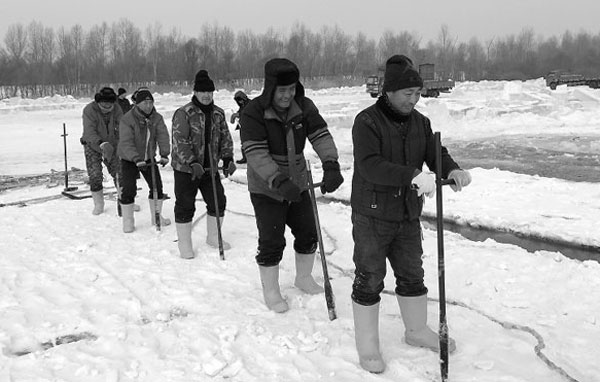Hardy workers relish cool job in Heilongjiang
Ice blocks cut from frigid Songhua River for annual Harbin festival
In mid-December, the temperature drops to nearly - 30 degrees C in Harbin, the capital city of Northeast China's Heilongjiang province.
At 3 am, the coldest part of the day that time of year, 42-year-old Wang Yandong always leaves his home in Tongfa village in Zhaodong, 30 km from Harbin.
Over the past eight years, Wang has spent 15 days during the coldest part of winter cutting blocks of ice from the frozen Songhua River. The blocks are then transported to the parks and roadsides where artists carve them into various sculptures to transform the city into a winter wonderland during the Harbin Ice and Snow World event.
"I have to get up at about 2 am and leave home after a simple breakfast," Wang said. "However, we are luckier than before because one of us who owns an eight-seat minivan can drive us to Harbin. In the past, we could only take a truck."
Wang's team has nine members, all from the same village. They have worked together for more than five years and work well with each other.
Usually they spend one hour on the road and begin to work at 4 or 5 am with the help of lamplight from the tall building across the river.
"They always laughingly call me 'captain'," said Wang. "I know it is because I have been in this line of work for the longest time."
In fact, Wang is an expert in ice cutting.
He is familiar with the situation of the frozen river and good at assigning tasks based on different strengths and talents of his team members.
"It is not so simple work, as you see. You have to be strong, quick and skillful," Wang told China Daily, "Most important, you should finish the task together with the whole team."
According to the ice engraving rules, each block of ice must be about 80 cm wide, 40 cm thick and 160 cm long.
"It will be not suitable for ice engraving if the ice is too thick or too thin," Wang said.
First, the team needs to locate the right place near the riverbank, where the ice is about 40 cm thick.
Then the crew uses a chain saw to cut the ice blocks into the required size.
"It is skillful work to cut the ice," Wang said.

















